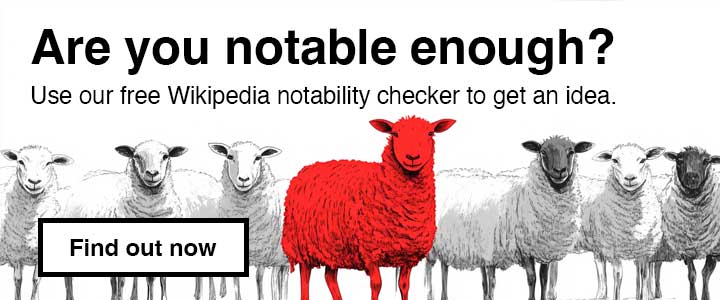Wikipedia Biographies of Living Persons: Easy Explanation Guide

What Is a “BLP” on Wikipedia?
A Biography of a Living Person (BLP) is any Wikipedia content—an article or a mention—about a person who is still alive (or recently deceased). This includes not just full articles, but also mentions on other pages, talk pages, and lists.
Wikipedia takes BLPs extremely seriously because the content has real-world consequences. Errors, bias, or sensationalism can harm reputations, invite legal challenges, or result in content deletion.
How BLPs Differ from Other Pages
- Higher standards apply: Every claim must be backed by reliable, third-party sources.
- Immediate deletion risk: Unsourced or poorly sourced negative content can be removed on sight.
- No speculation or gossip: Wikipedia is not a tabloid or a place for PR fluffiness.
- Not promotional: Even overly positive, promotional content is considered harmful under BLP policy.

What Notability Really Means for a Living Person
Wikipedia has a Notability Guideline for People, which says a person may merit a page if:
- They’ve received significant coverage from multiple independent, reliable secondary sources.
- Sources must be independent of the subject—not interviews, press releases, or company websites.
- The coverage must go beyond a trivial mention.
Not notable does not mean unimportant—it means the person lacks the necessary documented, in-depth media coverage.
Examples of qualifying sources:
- Articles in national newspapers (e.g., NYT, Forbes, WSJ)
- Profiles or features in independent magazines
- Books or academic publications discussing the person
Non-qualifying sources:
- Press releases
- LinkedIn profiles
- Your company blog or client website
- Interviews where the subject controls the narrative
- Content by Contributors (staff writers are best)
Red Flags for Marketers
These signals can spell doom or seriously complicate a Wikipedia article on a living person:
- Reliance on self-published or primary sources (like personal blogs, company bios)
- Negative or sensational content without citations
- Mention in only one major event (known as BLP1E: “biography of a living person notable for one event”)
- Lack of coverage in third-party publications
- Aggressive PR edits or COI (conflict of interest) contributions
Special Rules for BLPs
- Every word counts. Even neutral-looking content must meet standards of neutrality, sourcing, and tone.
- No original research. Editors cannot connect dots that sources don’t connect explicitly.
- No “attack pages.” Articles written with the intent to harm someone (even subtly) are deleted immediately.
- No “event-only” notability. If someone is only known because of a single incident, Wikipedia may choose to redirect their name to an event page rather than host a standalone bio.
Balancing Praise and Criticism
Wikipedia does allow criticism and praise, but both must:
- Be sourced to reliable secondary outlets
- Be presented in a calm, dispassionate tone
- Avoid giving undue weight to fringe or minority views
Avoid:
- Biased headlines like “Tech Genius” or “Disgraced CEO”
- Labeling (e.g., “fraudster,” “visionary”) unless reliably attributed
How to Know If Someone Is “Wiki-Ready”
Here’s a checklist you can use:
| Criteria | Explanation |
|---|---|
| 3+ solid profiles | National-level media coverage, not interviews or press releases |
| Diverse sources | From multiple unaffiliated outlets |
| Third-party focus | The person is the main topic in several sources |
| Sustained coverage | Not a flash-in-the-pan; articles spread over time |
| Impact | Recognition, awards, or influence in a notable field |
If you can’t check most of those boxes, creating a page may lead to rejection or deletion.
What Is an “Attack Page”?
These are hostile or disparaging pages, often:
- Created to shame, expose, or harm the subject
- Lacking balance, neutrality, or proper sourcing
Wikipedia deletes them immediately, and creating one can lead to editing bans.
Other Key Points Marketers Must Know
- You can’t write your own page. That’s considered a conflict of interest. Even “fixing errors” can backfire.
- Editors must cite their sources. No matter how “true” a fact is, it won’t survive without reliable citations.
- Wikipedia prefers no article over a bad one. A poorly written, promotional, or attack-style BLP will likely be deleted and salted (protected from recreation).
- Even positive content can violate policy if it’s unsourced or too flattering (see: “peacock language”).
Summary: How Marketers Should Approach BLPs
- Do your research. Collect strong, independent sources before drafting or requesting a page.
- Avoid bias. Let the sources do the talking—avoid exaggeration or editorializing.
- Be cautious. A bad or unqualified attempt can backfire and make it harder to publish later.
- Use the talk page. If you want to suggest changes to an existing BLP, use the “Talk” section with sources cited.
- Consider hiring experienced Wikipedia editors. But ensure they follow Wikipedia’s disclosure and neutrality rules.
Would you like a downloadable PDF version of this tailored guide for your marketing or client training materials?
Tags: Wikipedia, Wikipedia Writing.
